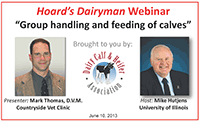
Due to improved building design, ventilation and feeding systems, some producers are now feeding their calves milk in group pens as opposed to individual pens or hutches. With a shift in management to group housing, the June 10 Hoard's Dairyman webinar sought to provide producers, nutritionists and consultants some insight into this emerging practice. Veterinarian Mark Thomas of the Countryside Vet Clinic in New York was the presenter.
Feeding calves an accelerated diet, which includes a higher plane of nutrition, reduces the effect of disease in milk-fed calves, as well as improving average daily gains. This really applies to calves housed in all types of facilities. Calves fed a higher plane of nutrition, ad libitum (all they want), produce more milk as cows. The enhanced milk consumption as calves resulted in 2.2 pounds as compared to 1.25 pounds of gain per day, netting 1,543 pounds of additional milk in first lactation. However, Thomas emphasized that colostrum is still important and feeding more milk later cannot truly replace high quality colostrum intake at birth.
The veterinarian also addressed the housing challenges for grouped calves. Ventilation is a significant factor in the animals' health. Just having a fan is not sufficient. Producers need to know air exchange levels on an hourly basis to best manage pen environment and optimize calf health and minimize illness.
The bedding and surface area is another consideration. Concrete is not required, but excellent drainage is a must. Options include gravel or sand. Calves should have 30 square feet of lying area. The "knee test" will determine if your bedding is too wet. If your pants get wet when you touch your knee in the bedding, that means you calves are exposed to that moisture, too.
Overcrowding leads to more illness. Additional respiratory issues were seen in pens with 12 to 18 calves, as opposed to calves with just six to nine head.
 Hygiene and attention to detail is needed throughout
Hygiene and attention to detail is needed throughout The feeding system equipment should be kept clean and not allow dried milk to accumulate in tubing. This can be a bit of a challenge if calves are using the system constantly, but regular cleaning is still needed. Cold milk discourages intake, so the temperature should be fed at 85 to 90ºF. Even during warm summer days, night temperatures can drop and the low milk temperature can reduce intake amounts. The pH of milk fed to calves should be 4.0 to 4.2, varying either way from this level will result in calf health issues. This is another reason to keep the total solids level in the milk (or milk replacer) consistent so the pH is stable. If you are acidifying milk, it must be cooled to below 75ºF degrees to prevent curdling before raising it back to 85 to 90ºF for drinking.
Calves should be fed ad lib, allowing them to eat anytime they feel the need. If calves are truly fed ad lib, there is no rush to the feeding area when an employee approaches. The calf drinks until full, rests and then returns to eat when it craves more. Thomas compared it to beef calves or foals, that can nurse at any time. "Calves are designed with the same desire to drink until satisfied," commented Thomas. When calves are full, they rarely suck on other calves because the need to suck is diminished.
The Dairy Calf and Heifer Association sponsored the June webinar. Next April 1 to 3, they will be holding their annual convention in Green Bay, Wis. Details at www.calfandheifer.org
The June webinar is archived and available for viewing.

The author is the online media manager and is responsible for the website, webinars and social media. A graduate of Modesto Junior College and Fresno State, she was raised on a California dairy and frequently blogs on youth programs and consumer issues.








